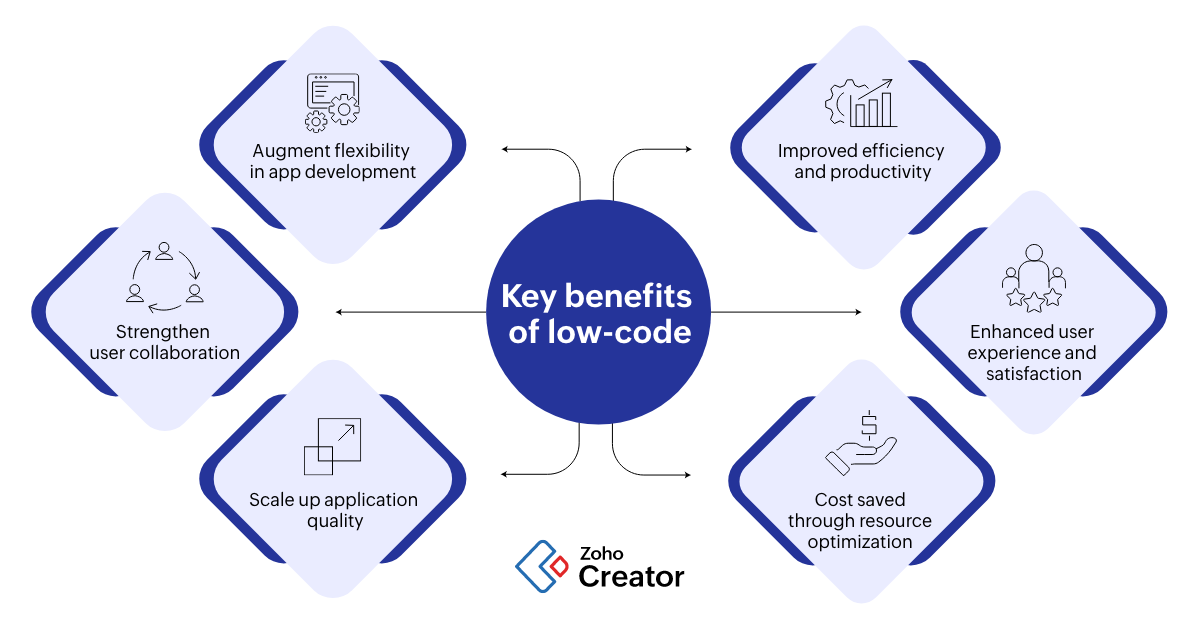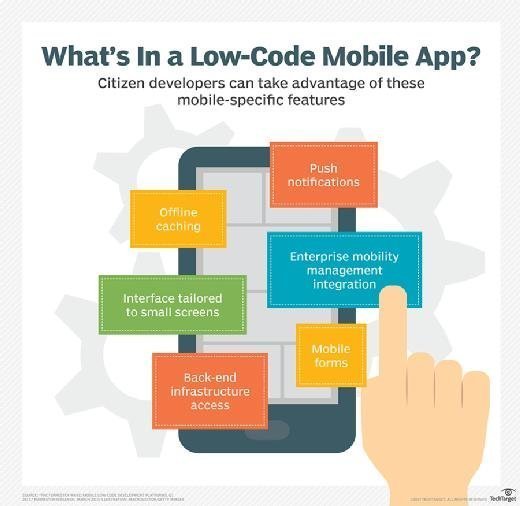Good Advice To Picking Low-code platforms for application development
Good Advice To Picking Low-code platforms for application development
Blog Article
Advantages Of Low-Code Application Development In Terms Of Speed
Visual Development Environment:
Drag-and-Drop Interfaces: Low-code platforms provide visual tools for designing applications. Drag-and-drop components are a great tool for developers to create apps without coding.
Many low-code platforms have prebuilt templates and components. This lets developers quickly build or prototype applications without starting from scratch.
Coding Requirements Reduced
Automated Coding Generation: Low-code platforms automatically generate code using the visual model developed by the developers. This helps reduce the need for manual coding and speeds up the development process.
Reusable component: Developers can use the same components for different projects. This helps reduce time spent on writing code and testing.
Collaboration Streamlined:
Low-code platform tools often include versions control, testing, or deployment. This allows for seamless collaboration between teams.
Citizen Development: Non-developers and business users can utilize intuitive interfaces to contribute to the development of applications which helps reduce bottlenecks triggered by a shortage of professionals to develop applications.
Rapid prototyping and iteration
Fast prototyping: Developers can create prototypes quickly to test ideas and gather feedback. This leads to shorter iteration cycle.
Simple Modifications: The visual design of low-code programming makes it simpler to make modifications and updates to applications. This speeds up the process of improving and refining applications based on user feedback.
Pre-built Integrations:
API Integrations: Low-code platforms usually have pre-built connectors for well-known APIs and services, reducing the time required to integrate external systems.
Data integration: Tools for data integration are built in to simplify the process.
Deployment Scaling
Many low-code platforms have an option to deploy applications in one click, which reduces the amount of time and effort needed to install applications.
Cloud-based solutions: Cloud low-code platforms are capable of scale and infrastructure management. Developers can then concentrate on functions and application logic instead of the deployment logistics.
In general, low-code development has the advantage in terms speed due to its capacity to automate and simplify many aspects of development. This allows for faster development of apps as well as easier adaptation to evolving needs. Have a look at the top rated Low-code Platform for application development tips for site examples including app dev platform, mobile app development platforms, jdbc server, low code development platforms, cloud software applications, cross platform mobile dev, paas service, low code development platforms, push notifications android, developing mobile apps and more.
Scalability And Flexibility Are The Two Benefits Of Low Code Application Development
Low-code applications offer several advantages when it comes to scaling. They are flexible and able to be modified to meet new demands. Here are the key benefits: Rapid Scaling:
Cloud-based deployment: A lot of low code platforms are cloud dependent. This lets applications grow seamlessly in tandem with the cloud infrastructure. This allows companies to handle increased workloads without having to worry about server management.
Auto-Scaling: This feature can automatically adjust the resources based on the demand. This ensures consistent performance at peak times with no manual intervention.
Flexible Architecture:
Modular Design: Low-code platforms encourage modularization of applications. This allows components to be developed independently and tested, as well as scalable. This flexibility increases the flexibility of an application and makes it simpler to update or expand specific parts of a program without affecting the entire system.
Microservices integration: The support for microservices architecture lets applications be designed as a collection of loosely linked services. This improves the flexibility and scalability.
Customizable Options:
Extensibility: Low-code platforms generally allow for customization of scripts and codes that lets developers expand the capabilities of apps beyond what is available in the box. This allows developers to satisfy their specific business requirements without any restrictions.
Third-Party Integrations: Businesses are able to integrate additional functionality and features into their applications through APIs and third-party providers.
Agile Development and deployment
Continuous delivery and deployment Low-code platforms can be used with agile methodologies and enable continuous integration and delivery (CI/CD). This enables rapid deployment of updates and new features, ensuring that the application can be updated quickly in response to feedback from users and market changes.
Iterative Design: Because low-code is an iterative process it is possible to gradually improved and enlarged. This permits controlled growth and reduces the risks of large-scale changes.
Resource Optimization
Efficiency in resource management: Low-code platform tools aid in optimizing resource usage by monitoring and regulating the performance of applications. This lets resources be efficiently used, and also to be increased or decreased according to the need.
Load Balancing: The integrated load balancing feature divides the workload evenly among servers. This enhances the application's ability to handle large volumes of traffic and also ensures consistent performance.
Global Reach:
Multi-Region: Platform deployments that use low-code are typically supported across multiple geographies and allow businesses to provide low latency access to all users. This is essential, especially for applications with global users.
Localization: Support for localization is built in, which allows applications to be adaptable to different languages or regional requirements. This increases flexibility for various markets.
Updates and maintenance:
Low-code software is visually appealing and are modularly built, which makes it easy to do maintenance. Updates and bug fixes are done quickly and without a lot of downtime.
Version Control Systems for Version Control assist in managing rollbacks and changes making sure that updates can be deployed safely and previous versions can be restored if needed.
Cost Efficiency:
Lower Development Costs: By reducing the requirement for extensive code, low-code platforms cut down on development costs and make it feasible to scale applications without a significant increase in development cost and effort.
Pay-As-You Go Models - Many low-code platforms have flexible pricing models, such as pay-as-you-go, which aligns costs with the actual usage, growth, as well as financial flexibility.
Low-code development offers businesses numerous advantages, including scalability, flexibility and adaptability. This lets them create robust, adaptable and scalable applications. These platforms enable quick adaptations to evolving requirements as well as efficient utilization of resources and continuous improvement. This guarantees that the application can evolve with the needs of the business. Take a look at the top rated Legacy application modernization with Low-code tips for site advice including push notifications, app modernization, push notifications, cross platform app dev, rapid application design, sso azure, develop web application, build with docker, database in azure, paas service and more.
Benefits Of Low-Code Application Development In Terms Of Limitations And Customization
Low-code application development is a balanced solution that has significant advantages in terms of overcoming limitations while also permitting customization. Here are some of the key advantages.
Overcoming Complexity:
Low-code development platforms are easy to use because they provide pre-built components, templates, as well as various other tools. They also facilitate rapid deployment of even the most complex applications.
Many platforms feature guided workflows, which help developers navigate their way through the complex procedures. They minimize the risk of errors and ensure the consistency.
Scalability Solutions:
Built-In Scalability: Low-code platforms usually have features that support an scalable architecture, which allows apps to take on more load without significant redevelopment.
Performance Monitoring: The integrated tools for performance monitoring and optimization help ensure that applications are efficient when they grow.
Security and Compliance:
Integrated security features: Low-code platforms include security measures like encryption as well as role-based access control and automated compliance checks that address the most common security issues.
Regular Updates: Platforms regularly change their security protocols as well as compliance measures, ensuring that applications remain secure against emerging threats.
Customization Features:
Extensibility:
Low-code platforms allow developers to enhance functionality beyond the standard offerings by adding custom code.
Developers can create extensions or modules to address specific business requirements.
APIs and Integration:
API Support: Comprehensive support for APIs facilitates seamless integration with other systems and services, which allows for customizing and connectivity.
Third-Party Services: Low code platforms have connectors designed to work with popular third-party services. This makes it much easier to modify and integrate apps.
Flexible Design for UI/UX
Customizable User Interfaces: Developers are able to modify and create user interfaces that meet branding and usability specifications, creating a tailored user's experience.
Responsive Designs: The applications can be tailored to fit different sizes of screens and devices.
Custom Business Logic:
Visual Workflow Builds Visual tools that permit customization of business workflows and rules and to design complex, tailored processes.
Conditional Logic and Scripting: Platforms permit the inclusion of conditional logic and custom scripting to handle specific business rules and scenarios.
Data Management:
Custom Data Modelling: Developers develop custom models to meet specific application needs. They can tailor processing of data according to a company's requirements.
Advanced Data Processing: Integration with advanced tools and capabilities for data processing allows for customizing how data is analyzed and utilized within the application.
Balanced Limitations and Customization
Frameworks, Standards and Standards:
Best Practices for Compliance Low-code platforms facilitate adhering to industry best practices and standards. This assists in maintaining high-quality robust, and secure applications.
Governance Frameworks: Integrated governance frameworks ensure that the customizations do not affect the integrity, conformity or the security of an application.
Iterative Development:
Rapid Prototyping: The capability to quickly prototype and test changes allows developers to modify their designs based on feedback from users, refining the application to better satisfy the user's needs.
Continuous Improvement: Low-code platforms allow continuous improvement, which allows for continuous customization and improvement when business requirements change.
User Empowerment
Enabling Citizen Developers by giving non-developers the opportunity to customize their applications through simple interfaces as well as low-code platforms they increase the number contributors who are able to improve and modify the application.
Support and Training Tools: A lot of platforms offer extensive training and support materials to allow users to customize their applications without compromising performance or stability.
Low-code development is an effective framework that permits a lot of flexibility while also addressing shortcomings. This ensures that businesses can develop and maintain applications that are tailored and efficient to meet their individual requirements while maintaining high levels of quality, safety, and scaling.